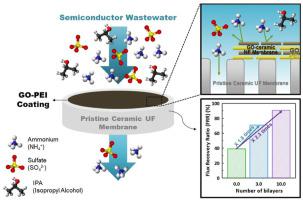Chemosphere ( IF 8.8 ) Pub Date : 2021-07-30 , DOI: 10.1016/j.chemosphere.2021.131745 Minju Cha 1 , Chanhee Boo 2 , In-Hyuck Song 3 , Chanhyuk Park 1

|
Ceramic membranes with high chemical and fouling resistance can play a critical role in treating industrial wastewater. In the present study, we demonstrate the fabrication of graphene oxide (GO) assembled ceramic nanofiltration (NF) membranes that provide effective ammonium retention and excellent fouling resistance for treating semiconductor wastewater. The GO-ceramic NF membranes were prepared via a layer-by-layer (LbL) assembly of GO and polyethyleneimine (PEI) on a ceramic ultrafiltration (UF) substrate. The successful fabrication of the GO-ceramic NF membranes was verified through surface characterization and pore size evaluation. We also investigated the performance of GO-ceramic NF membranes assembled with different numbers of bilayers for the rejection of ammonium ions. GO-ceramic NF membranes with three GO-PEI bilayers exhibited 8.4- and 3.2-times higher ammonium removal with simulated and real semiconductor wastewater, respectively, compared to the pristine ceramic UF substrate. We also assessed flux recovery after filtration using real semiconductor wastewater samples to validate the lower fouling potential of the GO-ceramic NF membranes. Results indicate that flux recovery increases from 39.1 % in the pristine UF substrate to 71.0 % and 90.8 % for the three- and ten-bilayers GO-ceramic NF membranes, respectively. The low-fouling GO-ceramic NF membranes developed in this study are effective and promising options for the removal of ammonium ions from semiconductor wastewater.
中文翻译:

研究氧化石墨烯陶瓷纳滤膜处理半导体废水的氨截留潜力
具有高耐化学性和耐污染性的陶瓷膜在处理工业废水方面可以发挥关键作用。在本研究中,我们展示了氧化石墨烯 (GO) 组装陶瓷纳滤 (NF) 膜的制造,该膜为处理半导体废水提供有效的铵保留和优异的抗污染性。通过在陶瓷超滤 (UF) 基底上逐层 (LbL) 组装 GO 和聚乙烯亚胺 (PEI) 来制备 GO-陶瓷 NF 膜。通过表面表征和孔径评估验证了 GO-陶瓷 NF 膜的成功制造。我们还研究了用不同数量的双层组装的 GO 陶瓷 NF 膜对铵离子的排斥性能。具有三个 GO-PEI 双层的 GO-陶瓷 NF 膜表现出 8。与原始陶瓷超滤基板相比,模拟和真实半导体废水的铵去除率分别高出 4 倍和 3.2 倍。我们还使用真实的半导体废水样品评估了过滤后的通量恢复,以验证 GO 陶瓷 NF 膜的较低污染潜力。结果表明,通量回收率从原始超滤底物的 39.1% 分别增加到三层和十层 GO-陶瓷 NF 膜的 71.0% 和 90.8%。本研究中开发的低污染 GO 陶瓷 NF 膜是去除半导体废水中铵离子的有效且有前景的选择。我们还使用真实的半导体废水样品评估了过滤后的通量恢复,以验证 GO 陶瓷 NF 膜的较低污染潜力。结果表明,通量回收率从原始超滤底物的 39.1% 分别增加到三层和十层 GO-陶瓷 NF 膜的 71.0% 和 90.8%。本研究中开发的低污染 GO 陶瓷 NF 膜是去除半导体废水中铵离子的有效且有前景的选择。我们还使用真实的半导体废水样品评估了过滤后的通量恢复,以验证 GO 陶瓷 NF 膜的较低污染潜力。结果表明,通量回收率从原始超滤底物的 39.1% 分别增加到三层和十层 GO-陶瓷 NF 膜的 71.0% 和 90.8%。本研究中开发的低污染 GO 陶瓷 NF 膜是去除半导体废水中铵离子的有效且有前景的选择。


























 京公网安备 11010802027423号
京公网安备 11010802027423号